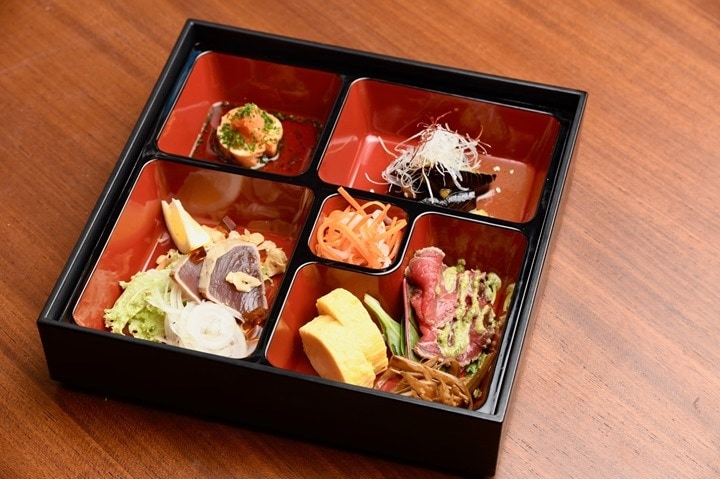The friend of Japanese cuisine always encounters the term bento box - and then, as an interesting variant, the name "Shōkadō bento box".
WHAT ACTUALLY IS A SHOKADO BENTO BOX?
The bento box is first of all a traditional small container for "food to go". Whether for farmers working the land, traders moving across the country, or fighters in war - the small containers have been used to take food with them since around the 5th century. And they were used in the way the observant Japanese like to eat: neatly separated according to their various components: Rice, vegetables, fish, meat.
BENTO BOXES HAVE AN ANCIENT TRADITION IN JAPANESE CUISINE
First it was bamboo tubes in which the food was packed, then they took small wooden boxes, which were divided into compartments. For better durability, they were often painted. And since these small boxes were beautiful and practical (and still are today), they could be used in many ways: to store valuable seeds, even precious jewelry. So, according to the story, did the monk Shokado Akinori, who lived in Kyōto Prefecture in the early Edo period (1582 - 1639). He took such a box, which had served a farmer as a seed container, painted it with small ink drawings and stored jewelry in it.
A MONK TURNED THE BENTO BOX INTO AN ART OBJECT
This artful old monk was also a master of the tea ceremony, which he performed in the Shrine Iwashimizu Hachimangu celebrated. Time passed and in the shrine stood the finely painted jewelry box of the old monk, until, almost 300 years later, in 1932, Yuki Teiichi discovered the small box. The box was made of wood, 3.5cm high and divided with a cross divider. Yuki had started a restaurant and, seeing the beautiful box, thought about how it could be used for fine dining.
He reduced the size of the box in the side dimensions, but made it a little higher and put a lid on it. The box was painted black on the outside and red on the inside compartments and named Shokado Box in memory of the monk who had made it a small work of art. In this noble box Yuki Teiichi served four small different dishes. They were to fit in measure to the vessel and "to the mouth", that is, a fine, balanced enjoyment, not too little, but not too luxuriant. This way of presenting various small noble dishes was highly appreciated at tea ceremonies.
THE SHOKADO-BOX BECOMES A TRADEMARK OF UPSCALE GASTRONOMY
In modern times, shokado bento box became known everywhere and gradually became the epitome of qulitative bento box. It is filled with special dishes in noble variations and bite-sized, measure and balance are among its characteristics. The Shokado box allows the fine enjoyment of the most diverse dishes, which are carefully arranged in the boxes. It does not stand for feasting, but rather for moderation, mindfulness and conscious enjoyment and is thus a typical sign of Japanese eating and living culture.
In today's use, these shokado bento boxes are not so much for takeout, but for upscale restaurant cuisine. In them, various delights are arranged in a carefully coordinated manner. That is why they are perfect for our restaurant sansaro. ideal to show the diversity of Japanese cuisine. How else can you let the guest taste the whole range of traditional cuisine from the land of the rising sun than in these deliciously filled boxes of a shokado box? We like to show Japanese cuisine by the example of sushi - but it is much more than just sushi. At Sansaro you can get an impression of it. We have used these boxes many times on the daily menu, for special events at lunch or dinner or to deliver a special snack to someone's home or company for a private or business catering. Therefore, if you have an opportunity, try what the Shokado boxes offer fine variety.
DIFFERENCE BETWEEN SHOKADO AND BENTO BOX
In modern Japan, the practical bento boxes are so widespread that their name is now also synonymous with "takeaway food". And, as you would expect, they have been used in the tradition-conscious and at the same time innovative Japan, the boxes have evolved and now take on all kinds of shapes and colors: they are now also available in fashionable colors (e.g. jeans blue, matcha colors, lilac and many more) but also decorated with patterns, painted with characters or with manga figures. Even the shapes have now left the simple square, the boxes were rectangular, oval, round or even designed as small figures. Multi-level boxes accommodate particularly extensive or several meals - the bento universe has become colorful and versatile and own cookbooks offer recipe suggestions for varied meals "to go".
In contrast to the traditional Shokado box - which is usually divided into four parts, possibly with a small extra area for a condiment - the modern Bento boxes are often not divided at all or only simply. Nevertheless, the basic principles of Japanese cuisine are also observed here: fresh vegetables, still crunchy, carefully prepared and seasoned, not everything mixed together, but the individual flavors clearly distinguished from each other and perceptible, in addition to taste, but separately, fish or even meat. The more one deals with the Japanese form of "lunch boxes", the more one realizes that this way of preparation can also provide valuable inspiration for our European cuisine. Perhaps these basic features of Japanese food culture, which can also be seen in the bento culture, are ultimately the reason why Japanese cuisine is also so highly regarded in this country.
We look forward to your visit, see you soon at the sansaro!







